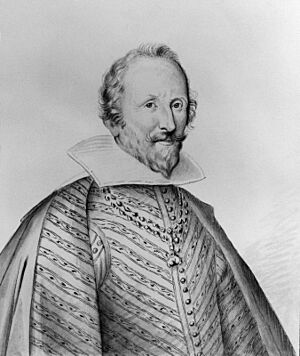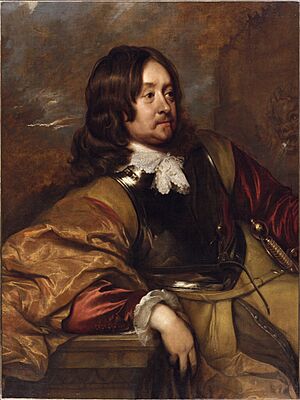John Colepeper, 1st Baron Colepeper facts for kids
John Colepeper, 1st Baron Culpeper (born around 1600 – died 11 July 1660) was an important English leader. He was a soldier and a politician who advised King Charles I during the English Civil War. He held important jobs like Chancellor of the Exchequer (which is like a finance minister) and Master of the Rolls (a top judge).
King Charles I rewarded him with a special title, making him a Baron, and gave him some land in Virginia, America. When King Charles II was in exile (living outside England), Colepeper stayed loyal. He helped King Charles II escape in 1646 and advised him from abroad. Colepeper returned to England with King Charles II in May 1660, but sadly, he passed away just two months later.
Contents
Early Life and Family History
The Colepeper family was a well-known family in Kent and Sussex, England, for many years. They often held important jobs, like being the High Sheriff of Kent. John Colepeper came from a part of the family that lived at a place called Wigsell in Salehurst, East Sussex.
His great-great-grandfather, Walter Colepeper, was an Under-Marshal of Calais (a military leader) and died in 1514. Walter's grandson, John Colepeper (born 1530), was John Colepeper, the 1st Baron's, grandfather.
Birth and Young Years
John Colepeper's parents were Thomas Colepeper and Anne Slaney. Anne was the daughter of Sir Stephen Slaney, who was a wealthy London merchant and once the Lord Mayor of London.
John's older brother, Slaney Colepeper, was supposed to inherit the family home at Wigsell, but he died in 1617. So, John Colepeper became the heir to Wigsell.
John's father and uncle were involved with the Virginia Company of London, which helped set up colonies in America. John himself joined the company in 1617. He was given the title of Knight in 1621. In 1623, he sold the Wigsell estate.
John married Philippa Snelling in 1628, but she passed away in 1630. They had a son and a daughter. In 1631, he married his cousin, Judith Colepeper. They had a large family together.
Serving in Parliament (1640-1644)
John Colepeper started his career as a soldier in other countries. He became known in England because he understood a lot about country affairs. He was often asked to share his knowledge with the King's council.
In April 1640, he was elected to Parliament for Rye. Later that year, he was elected for Kent in the Long Parliament. At first, he sided with the Parliament against the King. He spoke out against unfair business practices and helped with the impeachment (a formal accusation) of a judge named Sir Robert Berkeley.
However, Colepeper disagreed with Parliament when they wanted to change the Church of England too much. He worried about how these big changes would affect the country. He spoke against getting rid of bishops and against a bill called the Root and Branch Bill, which aimed to completely change the church.
On January 2, 1642, he joined King Charles I's side. He became the Chancellor of the Exchequer and a Privy Councillor (a close advisor to the King). He also helped write the King's responses to Parliament's demands.
Colepeper did not approve of the King's attempt to arrest John Pym and four other members of Parliament. However, he did support the King moving his court away from London. He was present at the Battle of Edgehill in 1642, a major battle of the Civil War. He even took part in a cavalry charge led by Prince Rupert.
In December 1642, King Charles made him Master of the Rolls, a very important judicial position. He was a key member of the King's Parliament in Oxford. In 1644, King Charles honored him by making him a Baron, with the title Baron Colepeper of Thoresway. This promotion made some people in the army, like Prince Rupert, dislike him.
A Royalist Abroad (1645-1660)
In March 1645, Lord Culpeper was sent with Edward Hyde to look after the Prince of Wales (who would later become King Charles II). In March 1646, after King Charles I's final defeat, Colepeper sailed with the Prince to France.
He strongly believed that the Royalists should work with the Scots by offering them some religious agreements. This idea was supported by the Queen and a French cardinal named Mazarin. He kept pushing this plan to the King.
In 1648, he joined the Prince in an unsuccessful naval trip. They returned to The Hague, where there were many arguments among the Royalist leaders. Colepeper even challenged Prince Rupert to a fight at one point!
In 1649, a document called the Charter of 1649 named Colepeper as one of the seven owners of a large area of land in Virginia, America, called the Northern Neck. His cousin, Thomas Colepeper, also owned a part of this land and later moved to Virginia.
After King Charles I was executed, Colepeper continued to urge King Charles II to accept the Scottish proposals. In 1650, he was sent to Russia, where he managed to get a loan of 20,000 rubles (Russian money) from the Tsar. Soon after, he went to the Netherlands to get military help.
Colepeper had to leave France in 1654 because of a treaty between Oliver Cromwell and Mazarin. He then lived in Flanders (part of modern-day Belgium). He traveled with Charles II to the south of France in 1659.
Death and Legacy
When the monarchy was brought back to England (the Restoration) in 1660, Colepeper returned home. However, he died just a few weeks later, on July 11, 1660. He was buried at Hollingbourne, Kent.
His son, John, 3rd Baron Colepeper, and his daughter, Elizabeth Hamilton, put up a beautiful white marble monument for him in Hollingbourne church in 1695. The monument has a long inscription that praises his loyalty, bravery, and wisdom. It mentions how he acted like a "brave Man at Armes" during the Battle of Keinton and how his "wise counsels" supported the King.
Many people who knew Colepeper agreed that he was a great debater and a valuable advisor. However, some also said he could be unstable and had an uncertain temper. The Earl of Clarendon, another important figure, generally spoke well of him and defended him against accusations of corruption.
Colepeper was also very good at predicting political events. In a letter written in 1658 after Oliver Cromwell's death, he accurately predicted how the political situation would unfold. He advised Royalists to wait for the right moment and take advantage of their opponents' disagreements. He even recognized George Monck as the person who could bring about the King's return.
Family Life
Lord Colepeper was married twice.
His first wife was Philippa Snelling. They married on October 29, 1628. She passed away in 1630. They had one son and one daughter:
- Alexander Colepeper, who married Katherine Ford. He died without having any children.
- Philippa Colepeper, who married Sir Thomas Harlackenden. They had two sons and two daughters.
His second wife was his cousin, Judith Colepeper. They married on January 12, 1631. They had several children, all baptized in Hollingbourne, Kent:
- Elizabeth Colepeper, who died as a baby.
- Thomas Colepeper, who also died as a baby.
- Thomas Colepeper, born in 1635, became the 2nd Baron Colepeper after his father. He was the Crown Governor of Virginia from 1680 to 1683. He had a daughter named Catherine, who married Thomas Fairfax, 5th Lord Fairfax of Cameron.
- Elizabeth Colepeper, born in 1637, married James Hamilton. They were the parents of James Hamilton, who became the 6th Earl of Abercorn.
- Judith Colepeper, born in 1638.
- John Colepeper, born in 1640, became the 3rd Baron Colepeper. He died without having any children.
- Cheney Colepeper, born in 1642, became the 4th Baron Colepeper. He never married, and when he died, the title of Baron Colepeper ended.
- Francis Colepeper, who died without having any children.
- Philippa Colepeper, born in 1649.





